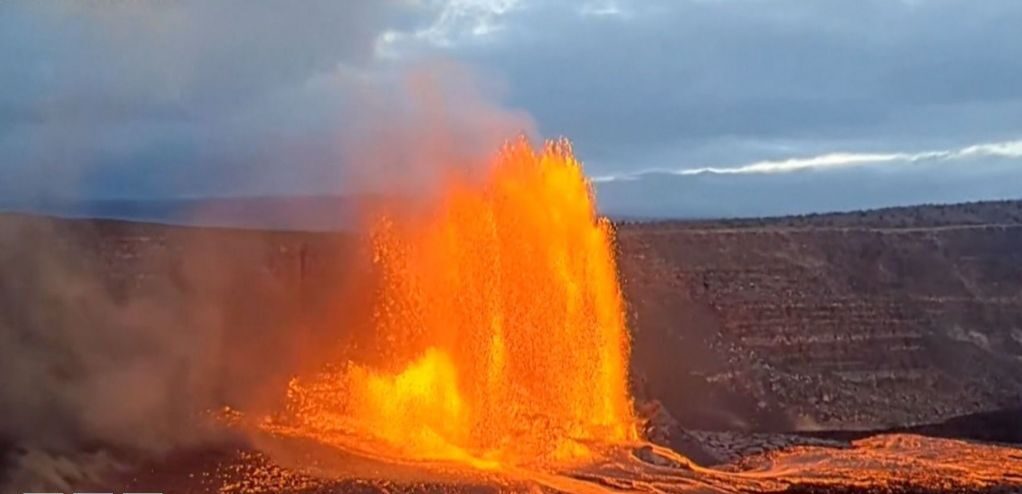Hawaii’s Kilauea volcano, one of the most active volcanoes in the world, has exhibited yet another breathtaking eruptive episode. On Sunday, May 25, 2025, at approximately 4:15 p.m. local time, the Hawaiian Volcano Observatory (HVO) confirmed that lava was projected into the air at remarkable heights, with plumes reaching up to 1,000 feet (about 300 meters). This occurrence has attracted significant attention from both local residents and global observers.
“The lava fountains from the north vent have been intense, with dramatic visuals that have captured the imagination of many, especially in the wake of previous eruptive events.”The Recent Eruptive Activity
The latest eruption, noted as the 23rd episode since December 2024, was characterized by a series of sustained lava fountains that continued to increase in intensity. The volcanic activity was notably centered around the north vent, where observations recorded lava shooting skyward amid a backdrop of darkening skies filled with ash and volcanic smoke.
Dramatic videos released by the U.S. Geological Survey (USGS) vividly depicted the lava’s furious ascent. Reportings from the HVO indicated that while the north vent was the main source of action, the south vent also experienced notable fountaining, with lava observed to reach heights of over 800 feet.
Impacts and Observations
The eruptive plume that rose as high as 5,000 feet was filled with gas, ash, and various volcanic materials, including scoria and Pele’s hair. These are essential indicators of the ongoing volcanic processes and can have substantial implications for the surrounding environment.
Officials from the HVO and other local agencies are closely monitoring the volcanic activity due to potential hazards it poses to nearby communities. Although the lava flow has remained primarily vertical, landing far from populated areas, variations in wind patterns could impact air quality and conditions for local residents.
Historical Context
Kilauea has a long history of eruptions, with activity frequently observed since its last major eruption began in December 2024. The volcano has a reputation for its dynamic behavior, with past eruptions showcasing both fierce and mild periods of activity.
Since the onset of eruptive activity in late 2024, the intensity of eruptions has varied significantly, sometimes lasting only 13 hours to extended periods over eight days. Such variability poses challenges not only for scientists monitoring the volcano but also for planning and safety measures in local communities.
Volcanic Monitoring and Public Awareness
The HVO plays a critical role in monitoring Kilauea and ensuring public awareness. As part of their responsibilities, they provide regular updates to local residents as well as potential visitors to Hawaii. This information is vital to mitigate risks associated with volcanic eruptions and to provide timely responses if conditions change.
Inhabitants of the nearby towns are advised to remain vigilant and to stay updated on the latest conditions reported by the HVO. The agency often issues alerts and recommendations on whether hiking trails should be closed or if particular areas should be evacuated in the event of escalating activity.
The Beauty and Danger of Kilauea
Kilauea continues to captivate visitors with its stunning displays of nature juxtaposed with the potential hazards it represents. Tourists flock to Hawaii Volcanoes National Park, hoping to catch a glimpse of the majestic eruptions or to walk the trails surrounding the fiery vents.
While the eruptions can be mesmerizing, they also remind us of the powerful forces of nature at work beneath the earth’s surface. Geological experts emphasize the importance of respecting the volcano and adhering to safety guidelines put forth by local authorities.
Looking Ahead
As the situation at Kilauea remains dynamic and ever-changing, scientists and volcanologists are committed to understanding the evolving patterns of this remarkable volcano. Each eruptive episode offers valuable data that contributes to safety protocols and predictive models that can help mitigate future volcanic eruptions’ impact.
Travel safety guidelines are thoroughly analyzed and communicated to those considering trips to Hawaii, especially during times of heightened volcanic activity. This ensures that tourism can safely exist alongside the natural phenomena that make the region unique and awe-inspiring.
Conclusion
The latest eruptions from Kilauea highlight both the beauty and danger of volcanic activity in Hawaii. As we continue to monitor this volcanic giant, it provides an ongoing reminder of nature’s power and the importance of scientific research in understanding our planet’s geological processes. For those fascinated by natural wonders, Kilauea remains a site of endless exploration and discovery, inviting new visitors to witness its spectacular lava fountains while adhering to safety measures put in place by the relevant authorities.

